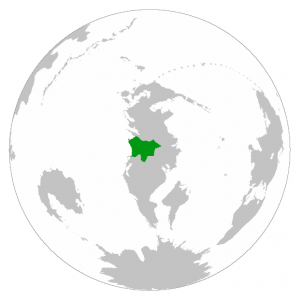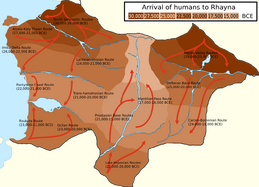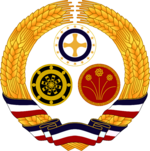UPRAN (Pacifica)
United Provinces of Rhayna, Alla-gy and Nea-gy Ηνωμένες Επαρχίες του Ράινα, Άλλα-Γη και Νέα-Γη | |
|---|---|
Motto: Long Live Us All Makros Zoi Mas Oloi Mάκρος ζωή Μας Ολοι | |
Anthem: Monopati gia Olous Μονοπάτι για Óλους | |
 Location of Rhayna in the South Pacific | |
| Capital | Pzarya |
| Largest city | Rouketa |
| Official languages | Aegean |
| Recognised national languages | Aegean |
| Sign languages | Aegean Sign Language Νοηματική Γλώσσα Αιγαίο (ΝΓA/NGA) |
| Ethnic groups (2022 census) | 18.67% Rhaynans 7.82% Alla-gyans 73.43% Nea-gyans 0.08% Romordians |
| Religion (2022 census) | 49.0% Religious 49.1% No religion 1.9% Unanswered |
| Demonym(s) | Rhaynan |
| Government | Federal democratic presidential constitutional republic |
• Prytanis of Rhayna | Romanos Kanidis |
• Viceprytanis of Rhayna | Yanni Nicolelis |
• Prytanis of Rhayna's Chamber of Deputies | Andrianos Remides |
• Archigos of the Konkresou | Daphne Arvaniteli |
• Archigos of Justice | Marinos Remiadis |
| Legislature | Genikes Kameres |
| The Konkresou | |
| The Rhaynan Vouli | |
| Federal independent republic | |
• Arrival of first humans | 30000 BCE |
• Multiple independent Aegean nations | 30000 BCE-1965 CE |
• UPRAN Republic | 6 May, 1965-2023 |
| Area | |
• Total | 931,948 km2 (359,827 sq mi) |
| Population | |
• 2022 census | 58,294,040 |
• Density | 189.23/km2 (490.1/sq mi) |
| GDP (PPP) | 2022 estimate |
• Total | 2.37 trillion |
• Per capita | $53,290.14 |
| GDP (nominal) | 2022 estimate |
• Total | 1.77 trillion |
• Per capita | $39,798.97 |
| Currency | Argyron (Γ⃫/γ̴) (ARG) |
| Time zone | UTC-2 (CCT) |
• Summer (DST) | UTC-1 (CCT) |
| Date format | dd/mm/yyyy CE |
| Driving side | right |
| Calling code | +65 |
| World Forum Code | RHA |
| Internet TLD | .rha, .ραι |
Rhayna (Aegean: Ράινα, Aegean pronunciation: [ɹ̠ɐin̪ɐ]), the United Provinces of Rhayna (Aegean: Ηνωμένες Επαρχίες του Ράινα, Aegean pronunciation: [in̪o̞m̪ɛ̝n̪ɛ̝s ɛ̝pɐrçiɛ̝s t̪u ɹ̠ɐin̪ɐ]) or the United Provinces of Rhayna, Alla-gy and Nea-gy (Aegean: Ηνωμένες Επαρχίες του Ράινα, Άλλα-γη και Νέα-γη, Aegean pronunciation: [in̪o̞m̪ɛ̝n̪ɛ̝s ɛ̝pɐrçiɛ̝s t̪u ɹ̠ɐin̪ɐ ɐlɐ'ɣi kɐi n̪ɛ̝ɐ'ɣi]), is a large country spanning the center of Cordilia. It is bordered by Qaweritoyu, the Republic of Yttria and the Republic of Sugovia to the north, the Weissersteiner Empire to the east, the Valkyrian Republic, Hystaiga and the Most Serene Imperial Republic of Ateemara to the east, and the Cordilian Sea to the west. Pzarya is the capital and second largest city of the UPRAN, while Rouketa, the largest city, is an important industrial and economic hub at the basin of Lake Kryo. At approximately 58 million inhabitants, the UPRAN isn't a densely populated country.
The UPRAN, or most specifically, the region of Moellia has one of the longest histories of any country, tracing its heritage along the water sources of the region back to 30,000 BCE. Considered one of the cradles of civilisation, Ancient Moellia saw some of the earliest developments of writing, agriculture, urbanisation, organised religion and central government. For the vast majority of it's history, the region has been divided into different isolated Aegean nations of varying size and lifespan.
In 1951, 2 years after the start of the Great War, the region entered a conflict called the Rhaynan Civil war, or more correctly, the Moellia War. This was the largest war ever fought in Moellia, fought between the communist faction composed of the People's Republic of Rhayna and the People's Republic of Nea-gy, and the fascist faction of the Republic of Pruecia. Although the war started during the Great War, most of it was fought during the Iron Century. After 14 years, in 1965, the war ended with the death of Elian Vasileiou and the start of the negotiations after the replacement of Vasileiou. These negotiations stablished the foundations for the formation of the United Provinces of Rhayna, Alla-gy and Nea-gy.
The UPRAN's current government is a constitutional federal semi-presidential republic led by prytanis Romanos Kanidis. The UPRAN is officially a laic nation, and Aegean is its official language. The great majority of its people live near the banks of the rivers, Lake Kryo, and the steepe of Nea-gy, where the only arable land is found. The large regions of the Rhaynan and Alla-gyan deserts, which constitute most of the UPRAN's territory, are sparsely inhabited. Most of the UPRAN's residents spread across the densely populated centres of Lake Kryo, Apoala river, and other locations with water sources. The UPRAN is considered to be a minor regional power in Cordilia. It is a developing country having a diversified economy. The UPRAN is a member of the World Forum and the Cross Pacific Space Cooperation. In July 11, 2024, the ambassador for the UPRAN, Andreus Savvidis, was elected as speaker of the World Forum.
Etymology
Moellia
Recent arqueological digs in the region have found various settlements dating as early as 30,000 BCE, all sharing one common feature: One or more figurines of what is believed to be the goddess of fortune and direction from Rhaynan mythology, Moella.
This, constrasted with the name of the region encompassing Moello-aegean populations being called "Moellia" (Aegean: Μοέλλια, Aegean pronunciation: [mo̞ɛ̝lʎiɐ]), meaning "Land of Moella", suggests that the three separated populations of Rhayna, Alla-gy and Nea-gy, named the region by the same name independently due to the goddess they all prayed to during the multiple generations of migratory groups through the continent of Cordilia.
Rhayna
Rhayna's name (Aegean: Ράινα, Aegean pronunciation: [ɹ̠ɐin̪ɐ]) has been distorted over the years, although in Aegean it can still be translated as “rain”, which is strange considering the main climate. Anthropological sites and written records show that the majority of tribes that started to settle in Rhayna noticed, from the heights of the Prostasia Range and Mt. Atzali, a reflective surface far away towards the south, and the relatively high amount of cloud coverage in its surroundings. Soon this noticeable water body would be called Lake Kryo, and the land surrounding it "Land of rain", or "Rhayna-gy" in Aegean, due to the precipitation produced by it. The lake's rainfall can go as far north as the city of Pzarya, and the lake would go on to become a center piece of Rhaynan culture, religion, and pride, among other. The Integrated Aegean Kingdoms of Rhayna would then be founded in 1100 BCE, popularizing the name of "Rhayna" over "Rhayna-gy".
Alla-gy
Alla-gy's name (Aegean: Άλλα-γη, Aegean pronunciation: [ɐlɐ'ɣi]) can today be translated as "Land of other". In some ancient texts that aren't fully translated to this day due to difference in script and the bad state of these, this name is used as in "Land of change" or "Another land", which would suggest that the land was named due to the finding of it after centuries of search.
However, other texts found further north along the Apoala use the name as in "Other's land" or "Land of Another", suggesting a far more mysterious theory of the Alla-gyans finding another tribe in the territory, lost or assimilated in the modern day.
Nea-gy
Nea-gy's name (Aegean: Νέα-γη, Aegean pronunciation: [n̪ɛ̝ɐ'ɣi]) its believed to come from the name "New land", name that most probably was coined by Moello-aegeans that first arrived to the territory.
History
Prehistory and Bronze Age history

There is early evidence of rock carvings and human remains in the province of Salyras near Prostasia around 30,000 BCE. In the 22th millennium BCE, a large number of nomads started migrating to the water sources and the ranges of Moellia with the desertification of the region after the end of the Last Glaciation Period Peak. Near the 12th millennium BCE, cultures of hunter-gatherers and fishers were replaced by agricultural cultures in the basin of Lake Kryo and the north of Nea-gy steppe. This agricultural economy spread quickly through the region as the populations retreated into the few fertile lands, setting the grounds for the creation of complex societies, permanent settlements and city-states. By about 4500 BCE, multiple Neolithic complex societies took root in the valleys of Imisy, Lake Kryo, Apoala and the Nea-gyan savannahs, while bronze working became widespreed.
[TBD]...
Geography
The UPRAN lies primarily between latitudes 30° and 19°S, and longitudes 40° and 25°2. At 931,948 square kilometres (359,827 sq mi), it is one of the largest countries in the South Pacific. Due to the extreme aridity of the UPRAN's climate in Rhayna and Alla-gy, population centres are concentrated along the narrow valleys of rivers, deltas, coasts of lakes and savannah of Nea-gy.
The UPRAN is bordered by Qaweritoyu, the Republic of Yttria and the Republic of Sugovia to the north, the Weissersteiner Empire to the east, the Valkyrian Republic, Hystaiga and the Most Serene Imperial Republic of Ateemara to the east, and the Cordilian Sea to the west.
The UPRAN is amongst one of the most water stressed country in the world.
Apart from state of Nea-gy and close to water sources, the majority of the UPRAN's landscape is desert, with a few oases scattered about. Winds create prolific sand dunes that peak at more than 25 metres (82 ft) high in Rhayna, while in Alla-gy dunes barely reach the 5 metres (16 ft) due to the surrounding mountains. Rhayna state hosts the highest mountain in UPRAN, Mount Mirena at 4,719 metres (15,482 ft).
Towns and cities include Parathyro; Ploio; Porta; Ryzi; Xeno; Pzarya, the actual capital; Thymiama; Nadena; Ippeas; Xenica; Tyri; Nkouver; Frachti Kuovale; Chrysi Thea; Asteria; Reton; Eklose; Rouketa; Antitheto; Ouman; Figouras; Kokaliaris; Stemma; and Bizelia in Rhayna; Ypsilos; Ntrouorora; Ontopoli; Ichlyria; Krinos; Kleise; Archaios; and Ypo in Alla-gy; and Oros; Tento; Voreios; Koila; Enois; Ourona; Pantoupoli; and Notos in Nea-gy.
Climate
Most of the UPRAN's rain falls in the summer months. In most of the UPRAN, rainfall averages only around 2–5 millimetres (0.079–0.197 in) per year and at intervals of many years. Around water sources, except the coasts with the Cordilian Sea, the rainfall can be as high as 410 millimetres (16 in), mostly between April and September, while in the state of Nea-gy it can reach between 900–1,500 millimetres (35–59 in) per year. Snow falls in the tops of the Defteros and Prostasia ranges, and frost is known to appear in the higher river locations during night due to the low temperatures the deserts and savannah reach.
The UPRAN has an unusually hot, sunny and dry climate. Average high temperatures are high in the interior and east, but very to extremely high in the rest of the country during winter. The southern trade winds consistently blow moisture out of Rhayna into the sea, but also blows moisture from Lake Kryo northwestwards towards the city of Pzarya, which helps to get more moderated temperatures along the path of this wind due to cloud coverage, especially at the height of the wintertime. The Kallinos is a hot, dry wind that originates from the deserts in the east of the Rhaynan Desert and blows in the autumn or in the early winter. It brings scorching sand and dust particles, and usually brings daytime temperatures over 40 °C (104 °F) and sometimes over 45 °C (113 °F) in the interior, while the relative humidity can drop to 5% or even less. In Alla-gy, due to its geographic placement between two mountain ranges, it is subject to a strong, boxed and northwards wind that blows moisture from the Cordilian Sea straight over the Apoala slope, depositing rainfall at the peaks of the Prostasia and Defteros, and even over Prostasia, feeding some of the biggest rivers in Rhayna. Nea-gy is the only region with moderate rainfall and temperatures, coming from the South Pacific Ocean. However, the rainfall happens mostly within winter months, when the land heats up faster than the ocean and draws moist water towards the Nea-gyan savannah, boxing it between the Defteros range into a monsoon. Meanwhile, the summers are dry and temperatures can be relatively high, although they don't reach the temperatures of Rhayna and Alla-gy
Prior to the construction of various dams in the major rivers of the UPRAN, these water currents would flood the relatively flat valleys of the territory at almost the same time in all the region, bringing with it rich soils.
The main dangers of climate change for the UPRAN is the rise of the sea level, increasing temperatures in the already scorching deserts, and the desertification of Nea-gy. The rise of the water level could sink the densely populated coasts of Rhayna, but specially the danger is due to the possibility of salt water mixing with the water of Lake Kryo, destabilizing the biodiversity and making the water undrinkable or making it unusable for human activities such as agriculture and industries. The temperatures in the deserts of Rhayna and Alla-gy reach new records each year, and droughts are becoming more extreme and more common, specially affecting the agricultural sector of the states of Alla-gy and Nea-gy. Added to these problems, the Eastern Cordilian desert is expanding through the savannahs of Nea-gy, crisis which currently is being fought in a conjoint effort of reforestation with the Unitary Peocracy of Huawan.
Experts have warned that, if actions aren't taken against climate change, by the end of the 21st century, tens of millions of Nea-gyans and Alla-gyans could migrate to Rhayna, overwhelming the system, or emmigrate towards other regions of Cordilia or the South Pacific. It could be expected to be one of the most catastrophic crises the United Provinces or the world could experience in the near future.
Biodiversity
The territory of the UPRAN can be subdivided into ten ecoregions: the Temperate Lake Kryo Basin, the Arid Northern Rhaynan Hot Desert, the Arid Southern Rhaynan Hot Desert, the Arid Western Alla-gyan Cold Desert, the Arid Eastern Alla-gyan Cold Desert, the Semi-Arid Northern Nea-gyan Savannah, the Semi-Arid Southwestern Nea-gyan Savannah, the Semi-Arid Southeastern Nea-gyan Savannah, the Prostasia Mountains and the Defteros Mountains. The UPRAN has banned bottom trawling in marine protected areas after the decrease in fishery yields in the decade of 2010-2020. Marine species such as the humpback and blue whales, the false killer whale and the monk seal habit the western coasts of the UPRAN in the Cordilian Sea, while in the desert, species like the fennec fox, the dromedary, the dorcas gazelle, the brown necked raven, the black kite, the golden eagle and the bearded vulture can be seen in varying numbers. In Nea-gy animals such as the Nilgai, the sloth bear, the thick-tailed pangolin

